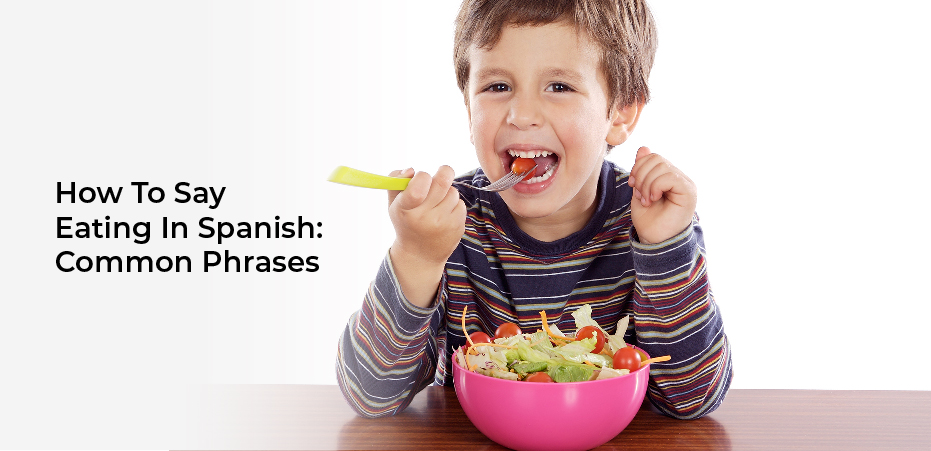Are you planning to travel to a Spanish-speaking country and want to know how to talk about eating? Or are you simply curious about how to describe your eating habits in Spanish? Look no further! In this article, we will explore the common phrases used to talk about eating in Spanish.
Firstly, we will cover the expressions for describing eating in Spanish. Whether you want to say that you are hungry, full, or just want a snack, we will provide you with the vocabulary and phrases you need to communicate effectively.
Additionally, we will discuss the food and meal-related vocabulary you need to know to talk about eating in Spanish. From breakfast to dinner, we have got you covered.
So, let’s dive in and learn how to talk about eating in Spanish like a pro!
Expressions for Describing Eating in Spanish
Let’s dive into some fun and flavorful expressions for describing how we eat in Spanish! One of the most common phrases used for eating in Spanish is “comer.”This verb means “to eat,”and it’s used in many different contexts, from describing a meal at a restaurant to talking about what you had for breakfast.
For example, you could say, “Hoy comí huevos y pan tostado.”(Today I ate eggs and toast).
Another common expression in Spanish for eating is “cenar,”which means “to have dinner.”This verb is often used to describe the last meal of the day, and it’s usually followed by the name of the food or dish that you had. For instance, you could say, “Anoche cené pollo con arroz.”(Last night I had chicken with rice for dinner).
Other expressions for describing how you eat in Spanish include “picar”(to snack), “beber”(to drink), and “degustar”(to taste), among others.
So, next time you want to talk about eating in Spanish, remember to use these fun and flavorful expressions!
Vocabulary for Food and Meals in Spanish
You’ll find many useful terms for food and meals in Spanish. For example, ‘desayuno’ for breakfast, ‘almuerzo’ for lunch, and ‘cena’ for dinner. Other important terms include ‘merienda’ for a snack, ‘postre’ for dessert, and ‘bebida’ for a drink.
To describe what you’re eating, you can use phrases like “I’m eating”–> “I’m eatin'”or “I’m going to eat”–> “I’m gonna eat”. To ask someone what they’re eating, you can say “What are you eating?”–> “Whatcha eatin’?”or “What are you going to eat?”–> “Whatcha gonna eat?”.
Knowing these terms and phrases will help you navigate menus and food-related conversations with ease when speaking Spanish.
Talking about Eating Habits in Spanish
Do you ever think about your daily food choices and how they impact your health and well-being? It’s important to pay attention to your eating habits and make sure you’re consuming a balanced diet.
In Spanish, there are many phrases you can use to talk about your eating habits. For example, if you want to say “I eat healthy,”you can say “como saludable.”Another phrase you can use is “como en casa,”which means “I eat like I’m at home.”This phrase is often used to describe someone who eats simple, home-cooked meals that are nutritious and filling.
If you’re trying to eat healthier, you might also say “estoy tratando de comer más verduras,”which means “I’m trying to eat more vegetables.”Whatever your eating habits may be, it’s important to be aware of them and make conscious choices to maintain a healthy lifestyle.
Polite Phrases for Inviting Someone to Eat in Spanish
Inviting someone to share a meal is a common social practice, and in Spanish, there are many polite phrases you can use to extend an invitation. For example, ‘¿Te gustaría comer algo juntos?’ means ‘Would you like to eat something together?’
Another popular phrase is ‘¿Quieres ir a comer algo?’ which means ‘Do you want to go eat something?’ This phrase is often used when making plans with friends or colleagues to grab a bite to eat, whether it be at a restaurant or someone’s home. It’s a casual and friendly way to extend an invitation and shows that you are interested in spending time with the person.
When extending an invitation to eat, it’s important to be polite and considerate of the other person’s schedule and preferences. Asking if they have any dietary restrictions or if they prefer a certain type of cuisine can show that you are considerate and thoughtful.
By using these polite phrases, you can make the other person feel welcomed and comfortable while enjoying a meal together.
Idioms and Expressions Related to Eating in Spanish
If you’re a Spanish learner, it’s worth exploring the rich variety of idioms and expressions related to food and eating. Not only will it help you better understand the language, but it’ll also give you a deeper insight into Hispanic culture.
For example, one common expression is ‘tener buen diente,’ which literally means ‘to have a good tooth,’ but is used to describe someone who enjoys eating and has a good appetite.
Another popular idiom is ‘estar como una vaca,’ which translates to ‘to be like a cow,’ but is actually a compliment meaning someone is well-fed and healthy.
There are also idioms related to specific foods, such as ‘ponerse como una sopa,’ which means ‘to become like a soup,’ or to become soaked through, and ‘estar hecho un flan,’ which translates to ‘to be like a flan,’ or to be nervous and shaky.
These expressions may seem strange at first, but once you start using them, you’ll find they add color and personality to your Spanish conversations. So don’t be afraid to experiment with new vocabulary and expressions, and enjoy the delicious world of Spanish idioms and phrases related to eating.
Frequently Asked Questions
What are some common Spanish dishes?
You might want to try paella, a traditional Spanish rice dish, or tapas, small appetizers often served with drinks. Other popular dishes include gazpacho, a cold tomato soup, and churros, a sweet fried dough pastry.
How does the culture in Spain differ from other cultures when it comes to eating habits?
When it comes to eating habits, Spain differs from other cultures in several ways. For example, they tend to eat later in the evening and take longer to enjoy their meals. They also place a strong emphasis on socializing and sharing food with others.
Are there any traditional Spanish customs or etiquette rules to follow when dining with others?
When dining with others in Spain, it is important to wait until everyone is seated and the host says “buen provecho”before beginning to eat. It is also customary to share dishes and not order separate meals.
What are some common Spanish words for different types of cuisine, such as Italian or Chinese food?
“You can use the words ‘comida italiana’ for Italian food or ‘comida china’ for Chinese food. Some other common words include ‘comida mexicana’ for Mexican food and ‘comida española’ for Spanish food.” ‘In addition, you can also use ‘comida francesa’ for French food, ‘comida japonesa’ for Japanese food, and ‘comida tailandesa’ for Thai food.’
How do Spanish eating habits vary in different regions of Spain?
In different regions of Spain, eating habits vary greatly. Coastal areas tend to have more seafood-based dishes, while inland regions have heartier meat and vegetable dishes. Wine is often enjoyed with meals.
Conclusion
So, now you know how to talk about eating in Spanish! With these common phrases, vocabulary, and idioms, you’ll be able to describe your meals and eating habits, invite others to join you for a meal, and even understand some of the cultural sayings related to food.
Remember to practice using these phrases in conversation to improve your fluency and confidence in speaking Spanish. Whether you’re dining out at a restaurant or cooking at home with friends, don’t be afraid to try out these expressions and enjoy the delicious cuisine of Spanish-speaking countries. ¡Buen provecho!
¡Enhorabuena! You’ve completed this guide on how to say eating in Spanish. With these useful phrases, vocabulary, and expressions, you’ll be able to talk about food and meals with ease and confidence.
By incorporating these Spanish phrases into your daily conversations, you’ll not only improve your language skills, but also gain a better understanding of the rich culture and traditions of Spanish-speaking countries.
So, go ahead and try out these phrases in your next conversation with a Spanish speaker – you’ll be amazed at how much more enjoyable and meaningful your interactions will become. ¡Hasta pronto!


